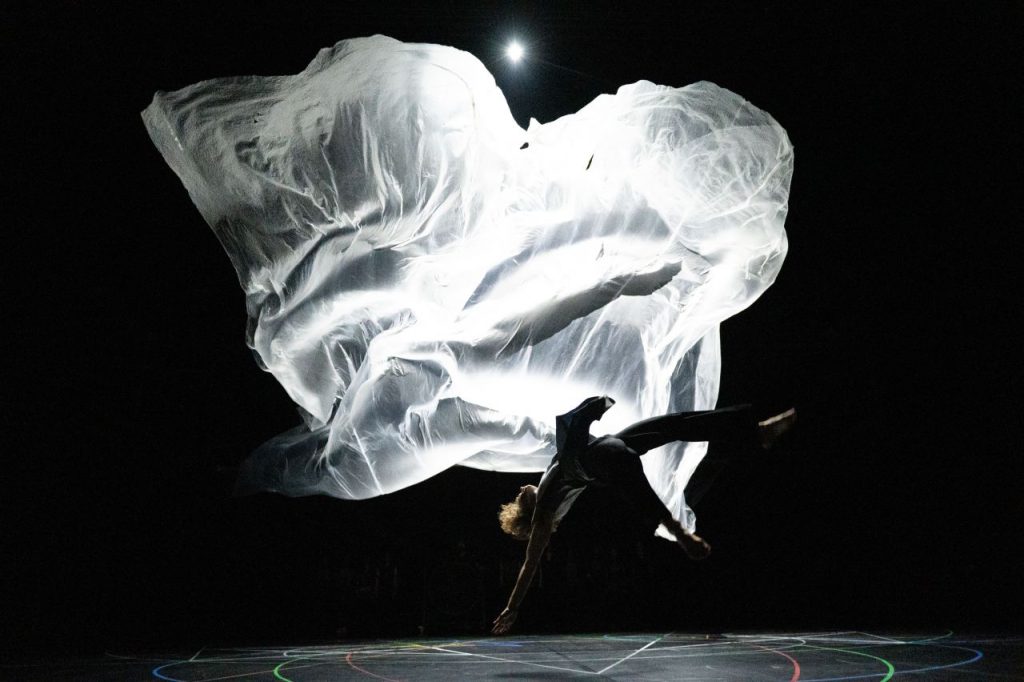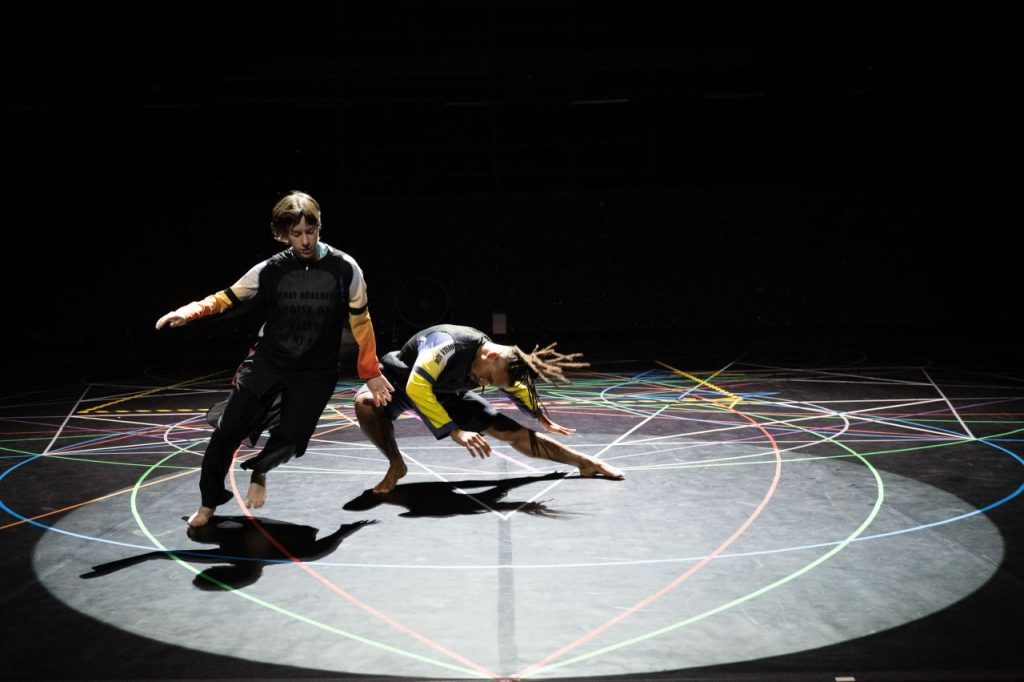For english version scroll down
Download programma ITA / Download program ENG
Info & Box office /Â 06.45553050
Dopo il successo di Drumming, l’icona della danza internazionale Anne Teresa De Keersmaeker torna al REF con la sua compagnia Rosas per proseguire la sua ricerca sul rapporto tra musica e movimento. EXIT ABOVE – after the tempest è un inedito confronto con le radici della musica pop occidentale. Un viaggio che, partendo dalla canzone Walking Blues del leggendario Robert Johnson, approda all’elettronica e alla dance di oggi. Ad affiancare le danzatrici e i danzatori della compagnia, sono, questa volta, Meskerem Mees (cantautrice fiamminga emergente di origini etiopi) e Jean-Marie Aerts, sound designer dei TC Matic, leggendaria formazione rock belga degli anni Ottanta. Al cuore di questo dialogo tra movimento e Blues, EXIT ABOVE – after the tempest pone un gesto primordiale come quello del camminare: il vagare, il marciare, l’isolarsi e il ritrovarsi uniti in un gruppo di persone per muoversi insieme sono per De Keersmaeker azioni di resistenza contro l’efficienza dell’iper-produttività odierna, strumenti in grado di generare pensieri e reminiscenze, di rivelare quanto il nostro mondo interiore possa assomigliare ad un paesaggio da attraversare. Possibilmente a piedi.
Guarda il trailer di EXIT ABOVE – after the tempest
Lo spettacolo è presentato nell’ambito del programma realizzato con Dance Reflections by Van Cleef & Arpels, il progetto con il quale la celebra maison sostiene la danza contemporanea internazionale e del quale, per il secondo anno, Romaeuropa è unico partner italiano e nell’ambito del focus dedicato alla scena fiamminga costruito in partnership con Flanders State of the art.
In EXIT ABOVE – after the tempest, Anne Teresa De Keersmaeker torna alla forma primaria del movimento umano – camminare – e alle origini della musica pop occidentale: il Blues. La coreografa è affiancata musicalmente da Meskerem Mees (1999) e dal produttore/chitarrista Jean-Marie Aerts (1951).
Negli ultimi anni ho lavorato molto con la musica classica. Bach naturalmente, e vari brani, dal Trecento alla musica contemporanea di Grisey e Reich. La musica è sempre stata la mia prima compagna e allo stesso tempo la mia maestra. Ho costruito regolarmente dei collegamenti con la musica pop. Per molte persone il pop è prima di tutto una musica da ballare. Ci ritrovo numerosi elementi che mi interessano, che mi parlano: il battito che ti invita a danzare, la melodia e anche l’aspetto lirico: la presenza del testo, delle parole, di qualcuno che ti parla.
Recentemente, mentre stavo mettendo via la mia collezione di LP, ho riportato alla luce un vinile nero dal quale è caduto un biglietto che non avevo mai letto. Era firmato da Jean-Marie Aerts. Conteneva delle domande: verrai mai ad ascoltarmi? Questa musica ti interessa?
Lo ha scritto nel 1996. All’epoca ascoltavamo Talking Heads e TC Matic. Dopo il lavoro, era questa la musica che ballavamo a Bruxelles. Un altro tipo di danza, ovviamente, ma sempre danza. Sul biglietto Jean-Marie aveva annotato anche un numero di rete fissa e un numero di fax. Così ho telefonato e lui ha risposto.
Anne Teresa De Keersmaeker
Da qui parte la collaborazione tra la coreografa e Jean-Marie Aerts chitarrista e sound designer dei TC Matic, leggendaria formazione rock belga degli anni Ottanta. Il gruppo, che alla voce vedeva il cantante Arno Hintjens, suonava un tipo di musica talvolta definita “eurorock”, contenente vari stili tra cui new wave, blues, funk, hard rock, avant-garde e chanson francese.
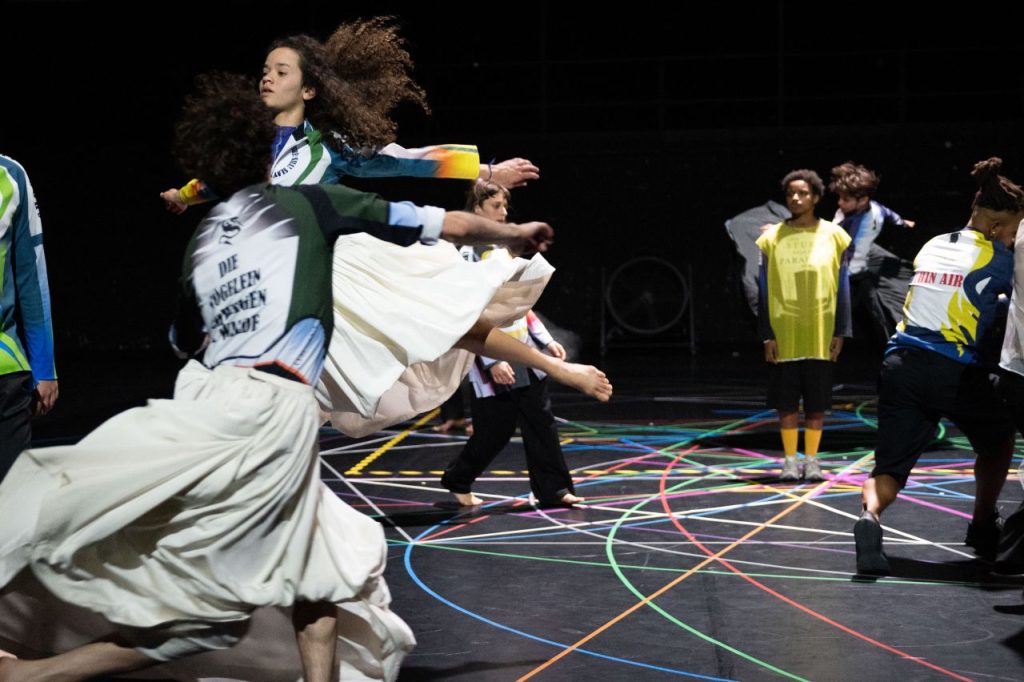
Tra ricordi di digging nei negozi di vinili londinesi e ricerche approfondite il blues è stato sin dall’inizio il motore che ha acceso la creativitĂ della coreografa e del sound designer Jean-Marie Aerts per comporre questo spettacolo. In particolare le note di Robert Johnson, un bluesman proveniente dal delta del Mississippi, il Delta Blues, che ha costituito una base imprescindibile per intere generazioni di musicisti a venire tra cui Muddy Waters, Bob Dylan, i Rolling Stones, i Cream, gli Allman Brothers, Johnny Winter, Eric Clapton, Jimi Hendrix, Jeff Beck e i Led Zeppelin.
In EXIT ABOVE – after the tempest il blues è un vero e proprio punto di partenza per l’ideazione dello spettacolo stesso. La coreografa, affascinata dai vecchi artisti blues che suonavano senza amplificatore, scandivano il ritmo battendo i piedi sul legno del palco, e cantavano e suonavano ad alta voce, ritrova in esso un’autentica forma di espressione artistica.
Il blues canta tristezza e gioia; la mia tristezza, la mia gioia ma anche la nostra tristezza, la nostra gioia. Siamo esseri sia individuali che collettivi e in ciò è presente una tensione per me cruciale. Nel blues c’è anche qualcosa che viene dall’alchimia: cantiamo la nostra tristezza, ma cantandola con altre persone, ne facciamo una forza, qualcosa di gioioso. Questa, secondo me, è la ragione del blues, del pop, anzi di tutte le forme d’arte. Se non possiamo comunicarlo a voce, lo cantiamo. E se non possiamo esprimerlo cantando, lo facciamo ballando. Mi rifiuto però di accettare qualsiasi forma di nostalgia: la storia della musica pop è anche quella della tecnologia, della produzione musicale, della registrazione, dell’adding fire: l’amplificazione, la manipolazione e la cattura del suono.
Anne Teresa De Keersmaeker
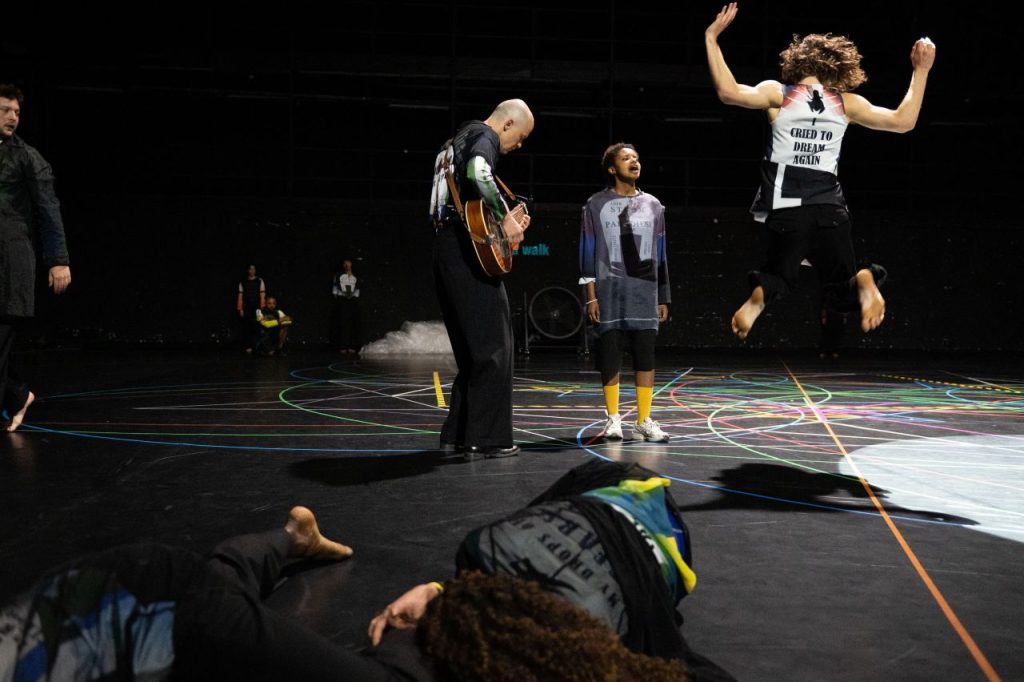
Anne Teresa De Keersmaeker insieme a Jean-Marie Aerts cercavano una voce che potesse accompagnare il progetto artistico capace di raccontare una storia attraverso il canto, una voce femminile toccante che da subito si è individuata nella voce della giovanissima folk-singer belga di origini etiopi Meskerem Mees che nello spettacolo viene affiancata da Carlos Garbin, chitarrista blues ed ex danzatore di Rosas.
Ascolta la voce di Meskerem Mees su Spotify
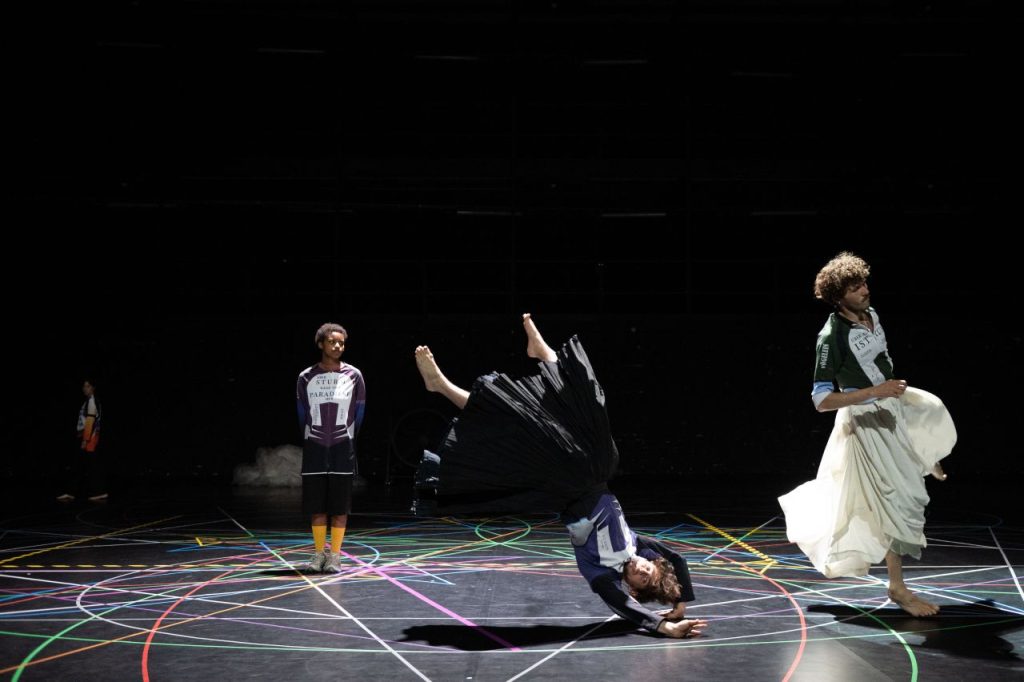
Anne Teresa De Keersmaeker: Between blues notes and movement
After the success of Drumming, international dance icon Anne Teresa De Keersmaeker returns to the REF with her company Rosas, to continue her research on the relationship between music and movement. EXIT ABOVE – after the tempest is an unprecedented journey into the roots of Western pop music that spans a multitude of sounds- from the song Walking Blues by legendary blues musician Robert Johnson, to Shubert’s Der Wanderer. This time, the dancers of the company are joined by Meskerem Mees – an emerging Flemish singer/songwriter of Ethiopian origin – who has composed a series of variations and adaptations of the “walking songs” and Jean-Marie Aerts, sound designer of TC Matic, the legendary Belgian rock band from the 1980s. EXIT ABOVE – after the tempest positions the primordial gesture of walking at the heart of this dialogue between movement and the Blues. For De Keersmaeker, the acts of wandering, of marching, of isolating oneself and of finding oneself united in a group of people in order to march together, are actions of resistance against the efficacy of today’s hyper-productivity, as well as tools capable of generating thoughts and reminiscences, of revealing how much our inner world can resemble a landscape to be traversed- possibly on foot.
Watch the trailer for EXIT ABOVE – after the tempest
The show is presented as part of the program created with Dance Reflections by Van Cleef & Arpels, the project with which the celebrated Maison supports international contemporary dance and of which, for the second year, Romaeuropa is the only Italian partner and as part of the focus dedicated to the Flemish scene built in partnership with Flanders State of the art.
In EXIT ABOVE, Anne Teresa De Keersmaeker returns to the primary form of human movement – walking – and to the origins of Western pop music: the Blues. She is flanked musically by singer-songwriter Meskerem Mees (1999) and producer/guitarist Jean-Marie Aerts (1951).
In recent years, I have been working a lot with classical music—Bach, of course, and various pieces from the fourteenth century to contemporary music by Grisey and Reich. Music has always been my first companion and, at the same time, my teacher. I regularly built connections with pop music. For many people, pop is, first and foremost, music to dance to. I find numerous elements in it that interest me, that speak to me: the beat that invites you to dance, the melody, and the lyrical aspect: the presence of the lyrics, of the words, of someone speaking to you.Â
Recently, while I was putting away my LP collection, I unearthed a black vinyl from which a note fell that I had never read. Jean-Marie Aerts signed it. It contained questions: Will you ever come and listen to me? Does this music interest you?
She wrote it in 1996. At that time, we were listening to Talking Heads and TC Matic. After work, this was the music we danced to in Brussels. A different kind of dance, of course, but still dance. Jean-Marie also noted a landline number and a fax number on the card. So I phoned, and he answered.Anne Teresa De Keersmaeker
This was the starting point of the collaboration between the choreographer and Jean-Marie Aerts, guitarist and sound designer of TC Matic, a legendary Belgian rock band of the 1980s. The group, which featured singer Arno Hintjens on vocals, played a type of music called “euro rock,” containing various styles, including new wave, blues, funk, hard rock, avant-garde and French chanson.
Between memories of digging in London vinyl stores and extensive research, the blues was the engine that ignited the creativity of choreographer and sound designer Jean-Marie Aerts to compose this show. Specifically, the notes of Robert Johnson, a bluesman from the Mississippi Delta Blues, formed an inescapable foundation for entire generations of musicians to come, including Muddy Waters, Bob Dylan, the Rolling Stones, Cream, the Allman Brothers, Johnny Winter, Eric Clapton, Jimi Hendrix, Jeff Beck, and Led Zeppelin.
In EXIT ABOVE – after the tempest, the blues is a natural starting point for the show’s conception. Fascinated by the old blues artists who played without amplifiers, the choreographer beat the rhythm by tapping their feet on the stage’s wood and singing and playing out loud, finding in it an authentic form of artistic expression.
The blues sings sadness and joy: my dismay, happiness, and despair. We are both individual and collective beings, and there is a crucial tension for me. In the blues, something comes from alchemy: we sing our sadness, but by singing it with other people, we make it a force, something joyful. That is why the blues, pop, and all art forms exist. If we cannot communicate it verbally, we sing it. And if we cannot express it by singing, we do it by dancing. But I refuse to accept any form of nostalgia: the history of pop music is also the history of technology, music production, recording, adding fire: the amplification, manipulation, and capture of sound.
Anne Teresa De Keersmaeker
Anne Teresa De Keersmaeker and Jean-Marie Aerts were looking for a voice to accompany the artistic project capable of telling a story through song. This touching female voice was immediately identified in the voice of the very young Belgian folk singer of Ethiopian descent, Meskerem Mees, who is joined in the performance by Carlos Garbin, blues guitarist and former Rosas dancer.
Listen to Meskerem Mees’ voice on Spotify.
Download programma ITA / Download program ENG
Info & Box office /Â 06.45553050


